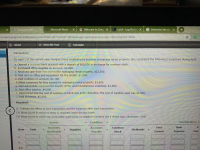
FINANCIAL ACCOUNTING
10th Edition
ISBN: 9781259964947
Author: Libby
Publisher: MCG
expand_more
expand_more
format_list_bulleted
Concept explainers
Question

Transcribed Image Text:### Transactions
On April 1 of the current year, Morgan Jones established a business to manage rental property. She completed the following transactions during April:
a. Opened a business bank account with a deposit of $60,000 in exchange for common stock.
b. Purchased office supplies on account, $1,800.
c. Received cash from fees earned for managing rental property, $22,300.
d. Paid rent on office and equipment for the month, $7,000.
e. Paid creditors on account, $1,100.
f. Billed customers for fees earned for managing rental property, $3,600.
g. Paid automobile expenses for the month, $750, and miscellaneous expenses, $1,000.
h. Paid office salaries, $4,000.
i. Determined that the cost of supplies on hand was $250; therefore, the cost of supplies used was $1,550.
j. Paid dividends, $5,000.
### Required:
1. **Indicate the effect of each transaction and the balances after each transaction**:
For those boxes in which no entry is required, leave the box blank. For those boxes in which you must enter a subtraction or negative number use a minus sign. (Example: -300).
#### Assets
| Item | Cash | Accounts Receivable | Supplies |
|--------------|------|---------------------|----------|
| a. | | | |
| Bal. | | | |
#### Liabilities & Stockholders' Equity
| Accounts Payable | Common Stock | Dividends | Fees Earned | Rent Expense | Salaries Expense | Supplies Expense | Automobile Expense | Miscellaneous Expense |
|------------------|--------------|-----------|-------------|--------------|------------------|------------------|-------------------|----------------------|
| | | | | | | | | |
| | | | | | | | | |
This table is intended to help you understand how each transaction impacts the various accounts in a typical balance sheet. Ensure to fill in each transaction as you go along and observe how it affects assets, liabilities, and stockholders' equity. For accounts that increase, simply add the amount; for accounts that decrease, use a minus sign before the amount to indicate subtraction.
Expert Solution
This question has been solved!
Explore an expertly crafted, step-by-step solution for a thorough understanding of key concepts.
This is a popular solution
Trending nowThis is a popular solution!
Step by stepSolved in 3 steps with 3 images

Knowledge Booster
Learn more about
Need a deep-dive on the concept behind this application? Look no further. Learn more about this topic, accounting and related others by exploring similar questions and additional content below.Similar questions
- Date General Account Titles and Explanations Ref. Debit Creditarrow_forwardPharoah Company had these transactions during the current period. June 12 July 11 Nov. 28 Issued 81,500 shares of $1 par value common stock for cash of $305,625. Issued 4,150 shares of $102 par value preferred stock for cash at $109 per share. Purchased 3,050 shares of treasury stock for $9,800. Prepare the journal entries for the Pharoah Company transactions shown above. (Record journal entries in the order presented in the problem. Credit account titles are automatically indented when amount is entered. Do not indent manually. If no entry is required, select "No Entry" for the account titles and enter O for the amounts.)arrow_forwardHow do you get the total for accounts recievable turnoverarrow_forward
arrow_back_ios
arrow_forward_ios
Recommended textbooks for you

 AccountingAccountingISBN:9781337272094Author:WARREN, Carl S., Reeve, James M., Duchac, Jonathan E.Publisher:Cengage Learning,
AccountingAccountingISBN:9781337272094Author:WARREN, Carl S., Reeve, James M., Duchac, Jonathan E.Publisher:Cengage Learning, Accounting Information SystemsAccountingISBN:9781337619202Author:Hall, James A.Publisher:Cengage Learning,
Accounting Information SystemsAccountingISBN:9781337619202Author:Hall, James A.Publisher:Cengage Learning, Horngren's Cost Accounting: A Managerial Emphasis...AccountingISBN:9780134475585Author:Srikant M. Datar, Madhav V. RajanPublisher:PEARSON
Horngren's Cost Accounting: A Managerial Emphasis...AccountingISBN:9780134475585Author:Srikant M. Datar, Madhav V. RajanPublisher:PEARSON Intermediate AccountingAccountingISBN:9781259722660Author:J. David Spiceland, Mark W. Nelson, Wayne M ThomasPublisher:McGraw-Hill Education
Intermediate AccountingAccountingISBN:9781259722660Author:J. David Spiceland, Mark W. Nelson, Wayne M ThomasPublisher:McGraw-Hill Education Financial and Managerial AccountingAccountingISBN:9781259726705Author:John J Wild, Ken W. Shaw, Barbara Chiappetta Fundamental Accounting PrinciplesPublisher:McGraw-Hill Education
Financial and Managerial AccountingAccountingISBN:9781259726705Author:John J Wild, Ken W. Shaw, Barbara Chiappetta Fundamental Accounting PrinciplesPublisher:McGraw-Hill Education


Accounting
Accounting
ISBN:9781337272094
Author:WARREN, Carl S., Reeve, James M., Duchac, Jonathan E.
Publisher:Cengage Learning,

Accounting Information Systems
Accounting
ISBN:9781337619202
Author:Hall, James A.
Publisher:Cengage Learning,

Horngren's Cost Accounting: A Managerial Emphasis...
Accounting
ISBN:9780134475585
Author:Srikant M. Datar, Madhav V. Rajan
Publisher:PEARSON

Intermediate Accounting
Accounting
ISBN:9781259722660
Author:J. David Spiceland, Mark W. Nelson, Wayne M Thomas
Publisher:McGraw-Hill Education

Financial and Managerial Accounting
Accounting
ISBN:9781259726705
Author:John J Wild, Ken W. Shaw, Barbara Chiappetta Fundamental Accounting Principles
Publisher:McGraw-Hill Education